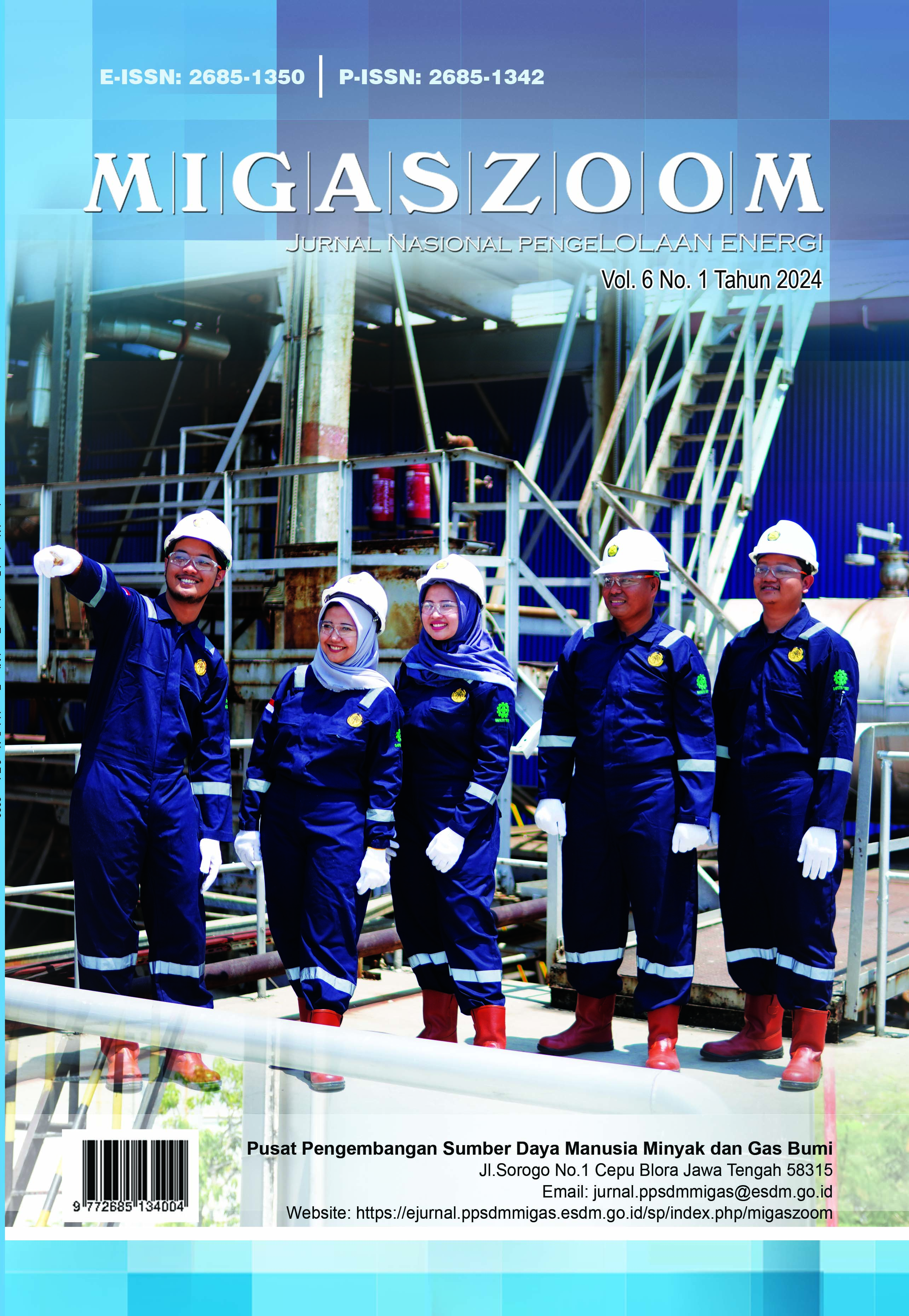Penurunan Titik Tuang pada Low Sulfur Cepu Residue (LSCR) Menggunakan Metode Penambahan Zat Aditif
DOI:
https://doi.org/10.37525/mz/2024-1/499Keywords:
LSCR, pour point, pour point depressant, wax depositionAbstract
Low Sulfur Cepu Residue (LSCR) merupakan produk akhir dari proses destilasi crude oil berkadar sulfur rendah dari kilang minyak PPSDM Migas Cepu. LSCR tergolong ke dalam minyak berat yang mudah membeku pada suhu ruang karena memiliki titik tuang tinggi, sehingga suhu residu perlu dijaga agar tetap tinggi untuk menghindari terjadinya wax deposition. Penelitian ini bertujuan untuk menguji zat aditif yang digunakan dalam proses penurunan titik tuang LSCR. Material yang digunakan adalah serbuk getah pinus dan serbuk EVA. Pelarut yang digunakan untuk melarutkan serbuk getah pinus adalah pertasol dan heksadekana, sedangkan serbuk EVA dilarutkan dengan xilena dan toluena. Metode yang digunakan untuk menurunkan titik tuang LSCR adalah penambahan zat aditif pour point depressant dan titik tuang diukur dengan metode standar ASTM D97. Hasil penelitian dapat disimpulkan bahwa penambahan zat aditif campuran getah pinus dan pertasol sebanyak 5% terhadap LSCR dapat menurunkan pour point hingga 47,5 ºC. Penelitian ini dilakukan dalam skala laboratorium, sehingga belum dapat dipastikan besar pengaruhnya dalam skala pabrik.
References
Bello, O. O., Fasesan, S. O., Macaulay, S. R. A., & Latinwo, G. K. (2005). Study of the influence of xylene-based chemical additive on crude oil flow properties and paraffin deposition inhibition.
Cao, J., Liu, L., Liu, C., He, C., (2022). Phase Of In Waxy Crude Oil In The Absence And Presence Of Pour Point Depressant. J. Mol. Liq. 345, 116989. https://doi.org/10.1016/j.molliq.2021.116989
Elarbe, B., Elganidi, I., Ridzuan, N., Abdullah, N., Yusoh, K., (2021). Synthesis, Characterization And Evaluation Of Stearyl Acrylate-Co-Behenyl Acrylate Copolymer As A Pour Point Depressant Of Waxy Crude Oil. http://doi.org/10.1007/s13202-021-01408-7
Fink, J., (2016). Chapter 6 - Drag Reduction and Flow Improvement, in: Fink, J. (Ed.), Guide to the Practical Use of Chemicals in Refineries and Pipelines. Gulf Professional Publishing, Boston, pp. 83–108. https://doi.org/10.1016/B978-0-12-805412-3.00006-4
Ghuiba, F.M., Khidr, T.T., Mahmoud, S.A., (2014). Preparation and evaluation of some surfactants as pour point depressants in oil field.
Hartiniati, H., (2006). Hidrokonversi Katalitik Residu Minyak Bumi: Pengaruh Temperatur Dan Waktu Reaksi. https://doi.org/10.14710/reaktor.10.2.82-87
Hartono, R., Yanuwiadi, B., & Hakim, L. (2018). The Potential of Sumatran Pine Rosin for Reinforcement-Steel Coating in Wet Environment. Indonesian Journal of Environment and Sustainable Development, 9(1).
Hasanah., (2022). Program Studi Nautika Diploma Iv Politeknik Ilmu Pelayaran Semarang.
Himanta Khaklari, G., Talukdar, P., (2021). Int. J. Eng. Appl. Sci. Technol. 6. https://doi.org/10.33564/IJEAST.2021.v06i01.05
Kandyala, R., Raghavendra, S. P. C., & Rajasekharan, S. T. (2010). Xylene: An Overview Of Its Health Hazards And Preventive Measures. Journal Of Oral And Maxillofacial Pathology: JOMFP, 14(1), 1.
Kencanawati, C. I. P. K., Sugita, I. K. G., Suardana, N. P. G., & Suyasa, I. W. B. (2017). Karakteristik dan Analisis Awal Getah Pinus merkusii (Pine Resin) dengan Variasi Suhu Pemanasan sebagai Alternatif Resin pada Komposit. In Proceeding Seminar Nasional Tahunan Teknik Mesin XVI (Vol. 16, No. 1, pp. 1-5).
Khadafi, M., Rostika, I., & Hidayat, T. (2016). Pengolahan gondorukem menjadi bahan pendarihan sebagai aditif pada pembuatan kertas. Jurnal Selulosa, 4(01).
Komariyah, N., (2022). Perbandingan Hasil Pengujian Pour Point pada Crude Oil Menggunakan Metode Uji ASTM D 97 dan ASTM D 5853. Maj. Ilm. Swara Patra 12. https://doi.org/10.37525/sp/2022-1/315
Li, N., Mao, G., Wu, W., Liu, Y., (2018). Effect Colloids Surf. Physicochem. Eng. Asp. 555, 296–303. https://doi.org/10.1016/j.colsurfa.2018.06.065
Lin, H., Yin, S., Su, B., Xue, Y., Han, S., (2021). Research Fuel 290, 120002. https://doi.org/10.1016/j.fuel.2020.120002
Rizqi, E.Y., Naryono, E., (2023). Teknol. Separasi 6, 381–390. https://doi.org/10.33795/distilat.v6i2.121
Ruengnam, T., & Maneeintr, K. (2022). Evaluation the Effect of Emulsion on Pour-Point Reduction of Oil from Fang Oilfield. In Recent Advances in Manufacturing Engineering and Processes: Proceedings of ICMEP 2021 (pp. 155-161). Springer Singapore.
Romeo, R., & Lemmon, E. W. (2022). Equations of State for n-Hexadecane and n-Docosane. International Journal of Thermophysics, 43(10), 146.
Semar, D., Ahadiat, N., (2022). Sci. Contrib. Oil Gas 30, 57–64. https://doi.org/10.29017/SCOG.30.3.980
Valente, A.C., Nunes, R., Lucas, E., (2022). Influence of Refinery Asphalt Residue Addition on Flow: A Study Using Waxy Model-System. J. Braz. Chem. Soc. https://doi.org/10.21577/0103-5053.20220090
Xia, X., Li, C.-X., Sun, G.-Y., Zhao, K.-K., Zhang, J., Yao, B., Yang, F., (2022). Performance improvement of Ethylene−Vinyl Acetate Copolymer Pour Point Depressant (EVA PPD) by adding small dosages of Laurylamine (LA). Pet. Sci. 19, 2472–2482. https://doi.org/10.1016/j.petsci.2022.04.002
Yang, F., Yao, B., Li, C., Shi, X., Sun, G., Ma, X., (2017). Performance (EVA) (PMSQ) : An Fuel 207, 204–213. https://doi.org/10.1016/j.fuel.2017.06.083
Yao, B., Li, C., Zhang, X., Yang, F., Sun, G., Zhao, Y., (2018). Performance (EVA) (PAMSQ) Fuel 220, 167–176. https://doi.org/10.1016/j.fuel.2018.01.032
Yoeswono, Y., Purwanto, D., Puspaningrum, D.K., (2022). Perengkahan Residu Minyak Bumi PPSDM Migas Dengan Metode Aquathermolysis. J. Nas. Pengelolaan Energi MigasZoom 4. https://doi.org/10.37525/mz/2022-1/366
Downloads
Published
How to Cite
Issue
Section
License
Copyright (c) 2024 azaliashafara@gmail.com Azalia Shafara Putri

This work is licensed under a Creative Commons Attribution-NonCommercial-ShareAlike 4.0 International License.
Use, distribution, and adaptation of this work are permitted for non-commercial purposes, under the following conditions:
- Proper attribution must be given to the original author and source (journal), including citation of the title, author name(s), and link to the original version.
- Modifications or adaptations must be released under the same license.
- Commercial use, including republication for financial gain, is not allowed without written permission from the copyright holder.










